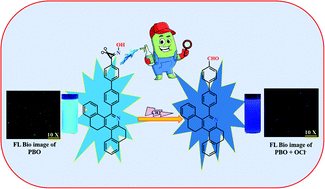A novel oxime-based fluorescent chemosensor (E)-2-(4′-(7,8,13,14-tetrahydrodibenzo[a,i]phenanthridin-5-yl)-[1,1′-biphenyl]-4-yl)ethen-1-ol (PBO) has been developed for the fluorimetric detection of hypochlorite ion (OCl−). On account of the optical behavior of the sensor PBO, distinctive spectral alterations in the presence of OCl− were detected. Furthermore, an obvious fluorescent color change from cyan to blue was also observed. An explicit linear relationship was found between the fluorimetric ratio of PBO and the concentration of OCl−. The detection limit (LOD) of PBO was evaluated to be 8 nM. The optical response was caused by the nucleophilic attack of OCl− on the imine group of the PBO probe, which stimulates intramolecular charge transfer. NMR titration investigation verified the detection mechanism. The PBO probe causes a quick spectral response towards OCl−, within 10 seconds. Furthermore, the practical utility of PBO was investigated through test paper analysis. The detection of OCl− in various water samples was also explored. The fluorescence bio-imaging experiment indicates the potential ability of the sensor PBO to detect OCl− in live E. coli cells.

